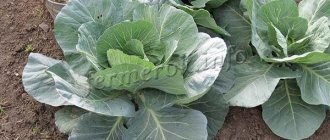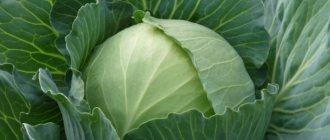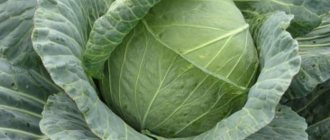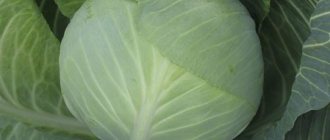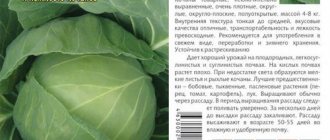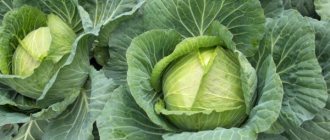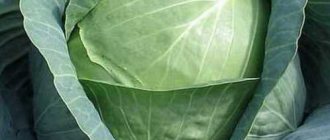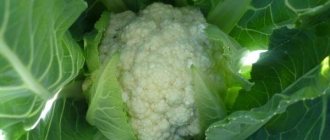Description of cabbage hybrid Aggressor F1
The new high-yielding hybrid of white cabbage deserves one of the honorable places among Russian varieties. With simple care, despite the average size of the heads of cabbage, the Aggressor demonstrates high yields - more than sufficient for cultivation for personal purposes and for sale.
Origin and development
Cabbage, originally from Holland, is rapidly gaining popularity in the Russian Federation and the CIS countries. Intended for cultivation in all zones of the country, except northern latitudes.
The hybrid was created by Dutch seed breeders (Syngenta Seeds BV). In 2003 it was included in the State Register of Russia. The name was given to the hybrid for its fast, powerful growth, resistance to pests, diseases and weeds.
Chemical composition and beneficial properties
The calorie content of Aggressor cabbage is 27 kcal per 100 g.
Contains a whole complex of nutrients and vitamins:
- Proteins, fats, carbohydrates, dietary fiber.
- 16 free amino acids (including tryptophan, lysine, methionine, tyrosine, histamine, etc.).
- Vitamins B, A, C, E, K, PP, as well as U, which has an antiulcer effect.
- The mineral composition is varied, including potassium, sulfur, calcium, phosphorus, magnesium, iron, cobalt, iodine, copper, zinc, manganese, etc.
Thanks to such a rich complex of chemicals, cabbage has many beneficial properties:
- Strengthens the immune system.
- Cleanses the body of toxins, cholesterol and other harmful substances.
- Prevents the development of atherosclerosis.
- Stabilizes blood sugar levels.
- Reduces the risk of developing pathologies of the heart and blood vessels.
- Improves liver and gall bladder functions.
- Reduces the risk of developing gout.
- Relieves joint pain.
- Prevents the development of benign and malignant neoplasms.
Features of application
The leaf pulp of the hybrid is juicy, crispy and very healthy, so it is often used to prepare fresh salads. It is added to first courses, stewed, fried, fermented, pickled. Aggressor cabbage is suitable for pickling and preparing other winter preparations, as it tolerates heat treatment well.
Ripening period
The ripening period for cabbage is medium-late, 120-130 days. Depending on the time of planting and weather conditions, the vegetable can reach full ripeness in mid-September - early October.
Productivity
The yield of the hybrid is stable and high - from 431 c/ha to 650 c/ha. The maximum figures were recorded in the Moscow region - 800 c/ha with a commercial product yield of up to 92-96%. Such figures are typical for industrial cultivation. Owners of private farmsteads manage to collect up to 10 kg from 1 sq. m.
Resistance to disease and cold
The vegetable has strong immunity. Thanks to the natural waxy coating on the leaf blades, the hybrid is highly resistant to thrips attack. It is not susceptible to fusarium. However, if agrotechnical rules are not followed, the following may hurt:
- Kiloy. A fungal disease that cannot be treated. Develops on the root system in the form of growths. The leaf blades gradually lose color and fade.
- mildew (downy mildew). A fungal infection appears as gray or yellow spots on the outside of the leaf and a whitish coating on the inside. Gradually the leaves die off and the plant dies.
Sometimes the crop is attacked by harmful insects: aphids, caterpillars, slugs and snails.
Cabbage tolerates periods of cold weather well, up to small frosts.
Characteristics of the appearance of leaves and heads of cabbage, taste
The rosette of the culture is large, raised above the ground. It is formed by small leaves of a gray-green color with a clearly visible waxy coating and wavy edges.
The fork of the hybrid has a dense structure, grows to medium size and a weight of 3-5 kg, sometimes under favorable conditions up to 6 kg. It has a round, slightly flattened shape. On the outside, the head of cabbage is colored greenish with a gray tint; when cut, it is bright white, sometimes with a slight yellowish tint. The length of the stalk is about 18 cm.
The dry matter content of the vegetable is 9.2%, and the total sugar content is 5.6%. Thanks to this, the taste of cabbage is high, the leaves are juicy and crispy.
In the photo - Aggressor F1 cabbage.
Suitable regions and climate requirements
Aggressor cabbage is grown in the Central region, Kuban, the Urals, and Siberia. The hybrid feels best in a temperate continental climate with not too cold winters and warm summers.
Pests and diseases of the Aggressor
Cabbage variety Aggressor has an innate immunity to point neurosis and fusarium wilt. It is avoided by thrips and cruciferous flea beetles. But it does not have 100% resistance to diseases and cabbage pests.
Table: Pest Control
| Pest | Signs of cabbage damage | Fighting methods |
| Cabbage aphid |
| Treat with a solution of Anabasine sulfate (for 10 square meters you will need half a liter of 0.2% solution). |
| Cabbage moth |
| Spray the cabbage with a solution of calcium Arsenate (10 g per 1 sq.m.), Chlorophos (0.5 liters of 0.15% solution per sq.m.) or Entobacterin (0.5 liters per sq.m.). |
| Cabbage fly | a grayish fly up to 6 millimeters makes holes in the roots | Per square meter you will need a mixture of wood ash, ground red pepper, tobacco in a ratio of 1:1:1. |
| Snails and slugs |
| Scatter Meta or Thunder capsules under the cabbage (3 pieces per plant). |
Photo gallery: pests affecting the Aggressor variety
Cabbage aphids lay eggs on stalks and heads of cabbage
Cabbage moth turns leaves into a sieve
The cabbage fly makes holes in the roots
Slugs and snails eat leaves, leaving holes in them
Table: diseases and their treatment
| Disease | Manifestation | Fighting methods |
| Kila |
|
|
| Blackleg |
| Add 50 g of TMTD per 1 square meter to the soil. |
| Downy mildew | a gray coating and yellow spots appear on the leaves | Spray the plants with 20 ml of Bordeaux mixture per plant. |
Photo gallery: diseases characteristic of the Aggressor variety
Clubroot leads to the death of cabbage. When infected with blackleg, the root collar rots.
Gray plaque and yellow spots on the leaves are a sign of downy mildew.
Advantages and disadvantages
According to reviews from gardeners, the hybrid has the following advantages:
- Excellently cultivated in areas with unfavorable climatic conditions and nitrogen deficiency. Gives 100% germination of seed.
- Non-seedling cultivation is possible.
- It has strong immunity to fusarium wilt, internal point necrosis, and is resistant to thrips.
- It is characterized by uniform ripening of heads of cabbage and high yields.
- It has an attractive appearance of forks that are not prone to cracking.
- Transports well.
- Universal to use.
Culture is not without its drawbacks:
- Has a relatively high cost of seeds.
- Susceptible to attacks by whiteflies and aphids.
- When salting yellowish heads of cabbage, a slight bitterness may appear.
Difference from other varieties and hybrids
Hybrid Aggressor F1 is distinguished by high growth vigor and is considered one of the most unpretentious crops:
- gives good yields on soils poor in organic matter;
- not afraid of drought;
- resistant to sudden weather changes;
- tolerates rainy seasons calmly (heads of cabbage do not crack).
Growing a persistent, unpretentious hybrid is the most successful option for beginning vegetable growers and those who cannot devote enough time to caring for cabbage plantings.
Pros and cons of the variety
- The Aggressor has a number of key advantages:
- stable high yields;
- ease of care;
- resistance to harmful environmental conditions;
- excellent presentation;
- possibility of growing without seedlings;
- excellent shelf life;
- resistance to many diseases and parasites;
- excellent taste;
- possibility of growing in areas with critical conditions;
- 100% seed germination.
- Cabbage is not without some disadvantages, among which farmers note the following:
- low resistance to clubroot infection;
- harshness of leaves (in some cases);
- possible slight bitterness when pickling.
Video: Cabbage variety Aggressor F1
Features of planting and growing
This cabbage is grown both in seedlings and without seedlings. The planting option depends on the climatic conditions of the region in which cabbage is planned to be cultivated. In a region with a cold spring, the seedling method is chosen. This helps protect the plant from spring frosts.
Preparing for landing
The planting process is preceded by a preparatory stage. It consists of several events.
Semyan
Seed material that has already been processed by the manufacturer is not soaked or processed. The remaining seeds are disinfected in a pink solution of potassium permanganate (2 g per 5 liters of water) for 4 hours. Some vegetable growers harden them. To make the seeds germinate faster, they are soaked in growth stimulants or germinated.
Seedlings
A specially prepared soil mixture consisting of garden soil and humus, taken in equal parts, is poured into small seedling boxes. Make furrows 1 cm deep, place seeds in them at a distance of 2 cm and lightly sprinkle with soil mixture.
Water with a spray bottle and cover with film. The containers are placed in a warm, dark place with a temperature of +22…+25°C. As soon as 4 true leaves are formed on the seedling, it is transplanted to a permanent place.
Non-seedling planting
The seedless method of growing cabbage involves sowing seeds directly into open ground.
Soil requirements
For higher yields, the soil composition must be fertile, with a low acid and alkali content (up to 4%). 3 weeks before planting, the beds must be fertilized: 5 kg of humus and 300 g of wood ash per 1 square meter. m.
Predecessors
Although the hybrid is not picky about soil, it is still worth observing crop rotation. The optimal beds are those where legumes, nightshade or pumpkin crops were previously grown. It is not recommended to plant cabbage after cruciferous vegetables: radishes, horseradish, turnips, rutabaga, and radish.
Dates, scheme and rules of planting
Planting is carried out from April 20 to May 1, when the air warms up to +20°C and there is no risk of return frosts. The bed is prepared in advance, preferably in a well-lit area.
Planting density and depth
The seeds are planted in moist soil according to a 50x50 cm pattern. 2-3 seeds are placed in each hole to a depth of no more than 1 cm.
Important! During planting, be sure to adhere to this pattern so that the bushes can freely develop both in height and width.
Features of cultivation
As soon as the first shoots appear, the cabbage is protected from direct sunlight and possible night frosts. Pegs are driven in around the perimeter of the bed and agrofibre or plastic film is stretched. When the seedlings grow up, the strongest ones are left, the rest are transplanted to another place or removed.
Nuances of care
Although the culture is unpretentious, it is still worth familiarizing yourself with the nuances of care.
Watering mode
Plantings require abundant and timely watering, otherwise moisture deficiency can lead to the death of young, thin, fibrous roots. For the first 2 weeks, cabbage is watered regularly once every 3-4 days in the morning and evening . For 1 sq. m is enough 6-8 liters of water.
Next, the number of waterings is reduced to once a week, and the volume of water is increased to 10-12 liters per 1 square meter. m. It is very important to adjust the regularity of watering depending on weather conditions. Watering is stopped 3-4 weeks before harvest.
Loosening and hilling
After watering and prolonged rains, the soil must be loosened, which ensures the penetration of air to the root system. The first time they are loosened to a depth of 4-5 cm, later - more deeply, to 8-10 cm. For better growth and the formation of adventitious roots, the plant is hilled up.
Top dressing
If the soil was sufficiently fertilized before planting the crop, fertilizing is not necessary. But in conditions of cultivation on heavy soils, additional application of fertilizers will not be superfluous:
- For the first time, cabbage is fed 3 weeks after planting. Take 10 g of saltpeter or urea per bucket of water. 200 ml of the prepared solution is poured under each bush.
- The second feeding is carried out before the formation of forks. To do this, dilute 10 g of potassium monophosphate in 10 liters of water and consume about 200 ml of solution per bush.
Measures to increase yield
To obtain abundant harvests of Aggressor F1 cabbage, it is important to adhere to the basic requirements for growing the crop:
- Follow the rules of crop rotation.
- Carry out activities to combat diseases and pests.
- Water regularly and fertilize in a timely manner.
Disease and pest control
To combat fungal diseases and pests, the following measures are taken:
- Clubroot cannot be treated, so diseased bushes are immediately removed from the garden and the soil is disinfected. For prevention, when planting seedlings, the roots are dipped in a clay solution.
- When infected with peronosporosis, diseased bushes are destroyed, and the rest are sprayed with a 1% solution of Bordeaux mixture or copper sulfate. Fungicides "Tiram" or "Planriz" are also used.
- Aphids are fought with a solution of the drug “Oxychom” (30 g per 10 liters of water).
- For caterpillars, an infusion is prepared from tomato tops: 2 kg of raw material is poured into 10 liters of water and infused for 24 hours.
- A solution of colloidal salt (20 g per 10 liters of water) helps against slugs and snails.
Aromatic herbs are planted near the cabbage plantings: mint, marigolds, sage, rosemary to repel insects.
Cabbage care
On the third day after planting, you should lightly dust the leaves of the seedlings with ash. Thus, they repel slugs and midges. Cabbage is not planted after radishes and rutabaga. This crop also grows poorly in soils with high acidity. Vegetables are watered with warm water and only in the morning or evening. The soil is regularly weeded and hilled. To repel insects, mint or marigolds are planted next to cabbage. The harvest takes place at the end of September. From mid-September, watering and fertilizing are completely stopped.
Harvest and storage
Cabbage ready for harvest is distinguished by the elasticity of its heads, its size and shiny leaves. They are cut off with a knife or an ax, leaving a stalk 3-4 cm long.
How and when to collect
Since Aggressor cabbage has a medium-late ripening period, the collection of heads of cabbage begins in late September - early October. By this time they reach full maturity. They are harvested in dry weather at a daytime temperature no higher than +8°C.
Storage features and shelf life
Fully healthy heads of cabbage, without signs of damage or disease, are subject to long-term storage. They are placed in a basement or cellar in 2-3 rows or hung on slats by the stalks. The storage area must be ventilated.
Important! The optimal temperature for storing vegetables is +1…+5°C. The humidity in the room where plugs are stored must be at least 90%. You should avoid exposure to light, otherwise the cabbage will begin to sprout.
When optimal conditions are created, cabbage can be stored for up to 6 months without losing its quality.
Planting through seedlings
The seedling method allows you to speed up fruiting and get a stronger harvest, but it is a more labor-intensive process, since it requires the gardener to grow seedlings. How to get strong seedlings and correctly transplant them to a permanent place of germination, we will consider further.
Growing seedlings
You need to start planting work on the 10th of April. To grow strong seedlings, you need to pay due attention to each of the following stages:
- Seed treatment . Keep selected seeds with a diameter of at least 1.5 mm in hot water (+50°C) for 20 minutes, and then in cold water for 2-3 minutes. You can simply soak them in Epin-extra solution for half an hour (1 drop per 50 g of water). After processing, dry the seeds.
- Substrate preparation . For cabbage, you need to prepare a soil mixture of turf soil, peat and sand in a ratio of 1:4:2. In addition, you can use disposable peat cups or tablets.
- Sowing . Plant the seeds in pots filled with soil to a depth of 1-1.5 cm. Throw 1 seed into each hole, cover with soil and water.
- Care. When the sprouts hatch, move the containers to a sunny place, preferably on a windowsill on the south or southeast side. They can also be kept in a greenhouse or greenhouse. In any case, the room temperature must be maintained at +15...+18°C. The first shoots will appear on days 5-7. They should be fed with mineral fertilizers, but it is better to refuse organic substances. The feeding scheme is as follows:
- after 2 true leaves appear, water the seedlings with a mixture of 2.5 g of ammonium nitrate, 1 g of potassium chloride and 4 g of superphosphate per 1 liter of water;
- after 12-15 days - water the seedlings with a solution of ammonium nitrate (3 g per 1 liter of water);
- 2-3 days before transplanting into open ground, fertilize the seedlings with a solution of 2 g of potassium chloride, 3 g of ammonium nitrate and 8 g of superphosphate per 1 liter of water, but this composition can be replaced with Kemira Lux fertilizer (1 tbsp. per 10 liters ).
- Hardening . 7-10 days before transplanting to a permanent place, the seedlings need to be hardened by taking them out into the open air during the day at a temperature of +5...+10°C, and in the evening bringing them into a warm place to protect them from night frosts. Aggressor seedlings become stronger after hardening, so they can better withstand harsh conditions.
Water the seedlings at the rate of 200 ml of solution per 1 seedling. Pour the mixture under the root of the plant, being careful not to touch the leaves.
Transplantation into open ground
Aggressor seedlings can be transplanted into open ground 35-40 days after emergence. It is advisable to do this in the evening or on a cloudy day, following the following sequence:
- Prepare holes in the garden bed at a distance of 50-70 cm. Keep at least 60 cm between rows.
- Fertilize each hole with a nutrient mixture prepared from 0.5 tsp. nitrophoska, 2 tbsp. l. ash and 1 handful of humus. Add the same amount of peat and sand, and then pour in 500 ml of water.
- Place cabbage seedlings in prepared holes, deepening to the level of the first leaf.
In the first week, the crops can be shaded with non-woven material or leaves. Experienced gardeners use spruce branches, burdock or birch leaves for these purposes.
To learn what rules you need to follow in order to grow strong cabbage seedlings, watch the video:
Tips and reviews from experienced gardeners
Gardeners growing Aggressor F1 note the high yield of the hybrid, good keeping quality of heads of cabbage and versatility of use.
Alexander, Kazan: “The cabbage hybrid Aggressor showed excellent results. It has a high yield; not a single head of cabbage was less than 3 kg. Aggressor F1 stores perfectly, especially when compared with other hybrids. If you keep the temperature within +3...+5°C, the heads of cabbage will lie quietly for at least six months, and nothing will happen to them.”
Semyon, Rostov-on-Don: “I have often heard that Aggressor F1 is very tough and hard, so summer residents do not want to grow it. But my family and I really liked this cabbage. Of course, the leaves are a little harsh, but you can cook anything from them. Cabbage is suitable for pickling, borscht, and cabbage rolls. The germination rate is high, and the Aggressor is stored until spring if you put it in the cellar.”
Growing without seedlings
In the Southern regions, Aggressor F1 cabbage can be grown directly from seeds, without prior propagation of seedlings. When planting, standard agrotechnical work is carried out. The only difference is the landing time. If the crop is grown by seeds, then they are planted at the end of April. Add 2-3 seeds to each hole. After the seedlings sprout from them, the strongest is selected from all of them, and the rest are pulled out.
After the seeds are planted, the rows are covered with black film until germination. At this time, the soil is kept in constant moisture, but it is important not to flood it. After the shoots emerge, the film is removed.
Reviews
Everyone who is interested in Aggressor cabbage reads the reviews. And what’s surprising is that you won’t find any negative experiences with growing this hybrid on the Internet. Everyone likes Aggressor, despite the fact that seed prices are quite high. However, judge for yourself.
Natalya, Yaroslavl
Aggressor learned about cabbage from a friend. At first I even thought that it was in vain that she was buying seeds so expensively. But when the time came to harvest, I became convinced of the proverb “the miser pays twice” from my own experience. My Slavia, in principle, produced good heads, but some of the seedlings died in their infancy, and some were subjected to Fusarium wilt, and many more forks were cracked. My friend’s 20 plants (that’s how many seeds she had in the bag) stood like little soldiers. The heads were all one to the same. Dense, beautiful, without the slightest signs of disease. Since then I have only imprisoned the Aggressor.
Ivan, Grodno region
The aggressor is the beautiful cabbage. Productive and ripens very quickly. Easily tolerates temperature changes. Copes relatively well with diseases and pests. And customers like it too. The heads of cabbage are always dense, round, and juicy. And their size is not very large. Therefore, they take it better than other varieties and hybrids that were previously grown.
Valya, Vinnitsa
The Aggressor seeds came to me by accident. The seller in the store gave them as a gift because I spent a large amount on purchasing seed material. I read the description on the bag and planted cabbage just so that the seeds wouldn’t be wasted, and I didn’t regret it. The cabbage not only grew beautiful and tasty, but stored perfectly all winter. Only towards the end of spring the top leaves began to rot. At the same time, over time, the taste of cabbage became more and more beautiful. So now Aggressor is my favorite variety!
Advantages
When describing the Aggressor cabbage variety, it is important to note that its popularity is growing every day. It has many advantages over other types:
- high taste qualities;
- during the growing season and storage, the heads of cabbage do not crack;
- the leaf is juicy and has a pleasant crispness;
- the high content of vitamin C allows the vegetable to be included in the diet of children and used as a dietary food;
- copies have a good presentation;
- powerful root system;
- tolerates transportation well, which makes it possible to grow vegetables for sale;
- the harvest ripens together;
- the heads of cabbage are aligned in size;
- seed germination is high, reaching 100%;
- tolerates nutritional deficiencies well;
- withstands high temperatures that are typical in the southern regions;
- tolerates low temperatures calmly;
- highly productive variety.
One of the main advantages of this variety is a stable and high yield. Unpretentiousness in the growing process makes the variety popular and beloved among consumers.
Cabbage Aggressor F1 is a universal variety. You can eat it fresh, prepare salads and borscht. The leaves are convenient to use in making cabbage rolls. Suitable for pickling, pickling and other winter preparations. The minimum shelf life of heads of cabbage is 5 months. On average, they last six months.
An excellent harvest can be harvested even in risky farming areas. The growth vigor of this variety is significant.
The small size of the heads of cabbage simplifies the transportation process. Specimens weighing 2.5-4 kg are more in demand when sold in markets and supermarkets.

